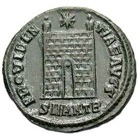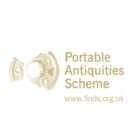
Roman Imperial Coinage
Imperial Roman Coinage
“The subject of Roman coinage is the largest in the numismatic world. Hundreds of books exist on the subject and new works appear every year.”
Well, the above statement is true but that doesn't mean that identifying your find has to be a great trial or requires a large financial investment in printed works. There are a great many resources for free on the Internet and we shall cover the most important here.
The first step in identifying Roman coins is to learn the rulers. Most coins until the 4th century carry a distinctive image of the ruler and it is the first point in identifying any coins from the 1st to 3rd century. If you are familiar with the names and images of emperors, identification becomes much easier. About the start of the 4th century, portraits became very similar and identifying by bust is very difficult.
Identifying the type of coin is important. Here we'll look at the types by metal. We won’t look at gold at all. Any gold solidi or aureii that may turn up can easily be identified using the resources described here.
Silver
Everybody recognises a denarius when they see one, though other silver issues exist. The denarius came into being around 211 BC and survived until about 240 AD. These coins became gradually debased, until at the end, they had only about 45% silver.
The Antoninianus was then introduced, the difference being (at the start) that this was a larger coin than the denarius, though with less silver content per weight. It can be identified from a denarius by the radiate or spiky crown the ruler wears, while the denarius shows the ruler with a laureate crown. These Antoniniani became more debased through the last half of the 3rd century until by the age of Claudius II and his brother Quintillus in 268-270, they were a scrappy mess with no silver content, but still recognisable as an antoninianus due to the radiate crown.
Britain is a little different from the rest of the Roman world as the rebel Carausius re-introduced the denarius for a short period, alongside his Antoniniani.
Denarius of Domitian 77AD
Antoninianus of Gordian III 241AD
Argenteus of Diocletian 287AD
Siliqua of Gratian 377AD


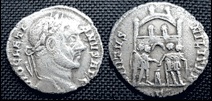
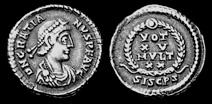
The next silver issue was a short lived one by Diocletian around 290, which we nowadays call the Argenteus. It wasn't succesfull and did not circulate widely.
After, very limited silver issues were made, but not in any amounts to be part of the monetary system. In fact, it wasn't until 355 that a new silver coinage was launched. This was the successful Siliqua, made from high purity silver. These coins carry the mark PS alongside the mintmark, meaning pusulatum (purified). Siliquae continued to be minted until about 400 AD. Other less common silver issues were also minted in this period, of which the larger Miliarense is the most usually found, though still very rarely. All these 4th century silver coins show the ruler with a pearl diadem on his head, rather than the radiate crown of the antoniniani and the laureate crown of the demari.
David Sears’ “Roman Silver Coinage” volumes one to five splendidly cover all these coins.
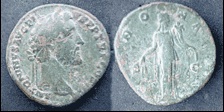
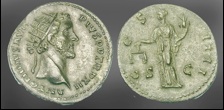
Sestertius (left, laureate bust) and Dupondius (right, radiate bust) of Antoninus Pius.
Base Metal
Covering the Imperial period only, the bronze coinage of the 1st and 2nd century were mainly the following:
Sestertius: Usually made in bronze or brass (orichalcum), measuring around 30 mm diameter and weighing a whopping 22-30 gram.
Dupondius: bronze or brass (orichalcum) around 11-15 gram. These coins can be identified from the larger Sestertius and the smaller As because from 65AD on, the rulers are depicted with the radiate crown.
As: a copper coin of about 10-12 grams.
Other denominations existed, mainly smaller units of an As, such as the Semis and quadrans, but are not often found (except at river crossings, when 1st century travellers used the smaller coins as an offering and tossed them into the water)
These large denominations gradually became less common throughout the 3rd century until the only coin in circulation, other than a little gold, was the debased Antoninianus.


Last of the Antoniniani Quintillus 270AD
The first Aureliani
Aurelian 273AD
Reforms
It was Aurelian (270-275) who stopped the rot, introducing a large flat coin, known today as the Aurelianus. These also had busts with radiate crowns and had a small percentage of silver (about 3%-5%). These lasted until Domitians reform during his reign. We have covered his ill-fated silver issue, but his main success was with the coin we now call the Folles or Follis which slowly replaced the Aurelianus. The Follis had a bust with a laureate crown. At first, this was a chunky coin of some weight, but gradually became reduced in size until the age of Constantine.
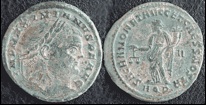
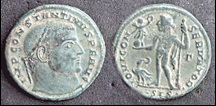
A large Follis of Maximianus 301 AD
A later smaller Follis of Constantine 315 AD
4th Century Base Metal coinage.
The coinage of the 4th century began with the large follis, which became gradually reduced in size, weight and silver content, which was small to begin with. Many reforms were made in the 4th century, which saw all the coinage being withdrawn and replaced by something bigger and better, but which also didn't last long and the bronze issue become smaller throughout the 4th century. It is from this period that most of the coins we find nowadays come from as they were minted in their millions. The coinage of the period usually has busts that are laureate or have a diadem rather than a crown.

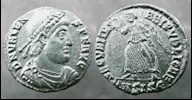
A Constantinian period nummus, and one of Valentinian period, busts with pearl diadem
Legends
Identifying coins through their legends is the key to ensure correct identification. However, on the Roman Imperial coinage (that which doesn't include Republican nor Provincial coinage) there are, at my count, 3053 different obverse legends. There are many online search engines to identify coins through a full or partial legend, both obverse and reverse. All give a little information and advice in recognising roman script and style. Mintmarks are also listed and explained.
Books and sites
The standard publications for referencing Roman coins are the volumes of Roman Imperial Coinage (RIC), which have been written over the last century in nine volumes. Obviously, not often found in every household!
The Sears Book 'Roman Coins and their values' is a serious starter book, though it only covers some coins of each ruler.
Recently, ERIC (Encyclopaedia of Roman Imperial Coinage) by Rasiel Suarez at Dirty Old Coins has been published. Full of glossy photographs of thousands of coins, sadly, the first edition was full of errors, but as a new issue, ERIC II is now available, a corrected version of the original is now available as a free DOWNLOAD
ERIC II boasts that it has more coins in it than RIC and the book weighs in at nearly five kilos.
WILDWINDS is an excellent online site with thousands of examples of roman coins in colour with full descriptions and also legend search engines. Run by the knowledgeable Dane Kurth, this site improves every day.
Dane also hosts an excellent site called COIN STUFF which has downloadable spreadsheets of just about every issue of 3rd and 4th century base metal coinage. These sheets are an absolute must for anyone who seriously wants to identify bronze coinage from that period.
My own spreadsheet of Roman Coin Legends, which carries every single obverse legend, can also be DOWNLOADED
Steve Gaunt 19 Sept 2010

BUST TYPES
LATE REVERSES
WILDWINDS
EXCEL SHEETS
Quick links to Roman Imperial Research & Identification Sites By Search Reference Type

FITZWILLIAM
PAS
UKDFD
FAKES

